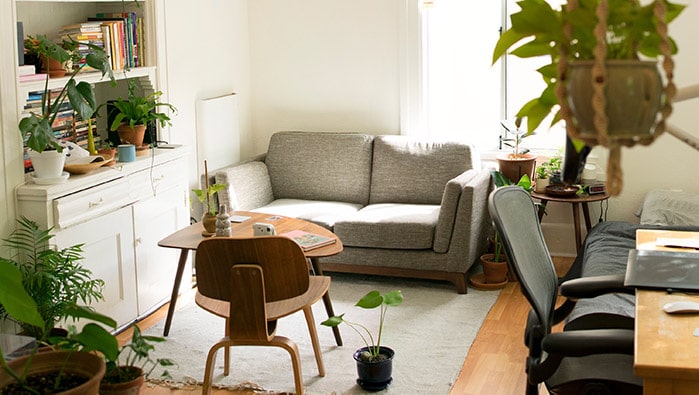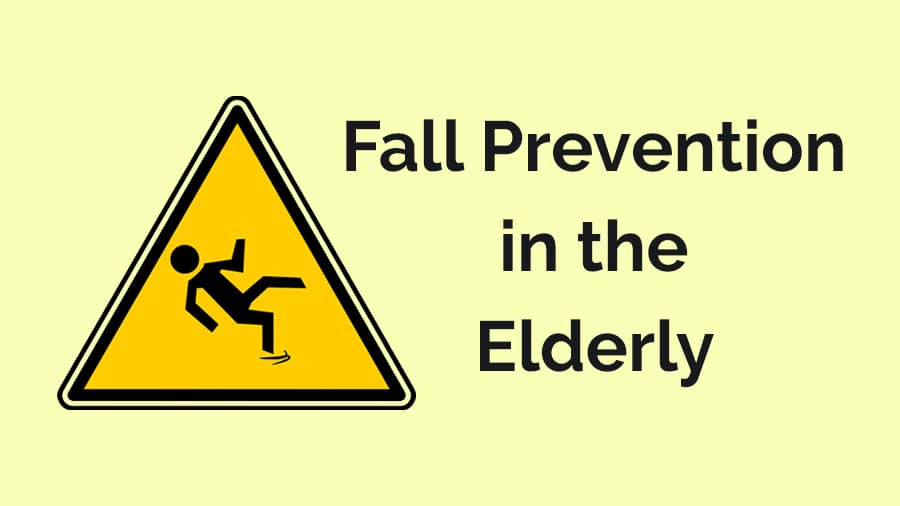In this post, I’ll show you the most effective measures you can take to prevent seniors from falling at home. Falls are not uncommon among seniors and fall-related accidents often have serious consequences.
According to the CDC (Centers for Disease Control and Prevention), each year at least 285,000 older adults are admitted to hospitals for hip fractures caused by falls. Data also says that every fifth fall results in a severe injury. It shouldn’t be this way. The vast majority of falls can definitely be prevented by taking the right precautions. Let’s see how you can reduce the risk of fall-related accidents.
So what are the most important precautions to take when it comes to fall prevention at home?
In brief:
First, eliminate hazardous environmental factors: make sure that lightning is adequate at any time of the day, remove obstacles, and get rid of slippery surfaces.
Next, clear up clutter and repair uneven flooring. Install grab bars and other assistive devices that can help seniors with mobility difficulties.
Improve health conditions that can contribute to falls (read on to learn exactly how you can do that). Remember: fall-related accidents are not a normal part of aging.
Now, let’s see the details:
What are the Most Common Causes and Risk Factors of Falls in the Elderly?
Environmental Factors
- Poor lighting
- Slippery floors and rugs
- Uneven floor or carpet
- Unsafe stairs
- Absence of assistive devices
- Obstacles, cluttered cords
- Poor footwear
- New environment
Conditions that Can Contribute to Falls
- Weak muscles
- Mobility difficulties
- Pain and disease of joints
- Balance and stability issues
- Visual impairment
- Hearing loss
- Hypotension
- Arrhythmias
- Anemia
- Dehydration
- COPD
- Cognitive impairment
- Alcohol dependency
- Depression
- Parkinsonism
- Fear of falling
- Use of certain types of medication (e.g. sedatives, antidepressants, tranquilizers)
How to Prevent Falls in the Elderly at Home?
So how can you reduce the risk of falling at home? Don’t just do random changes: you can achieve much better results by following a fall prevention strategy.
In the first step, you should evaluate the environment: what potentially hazardous things can you notice? Think about what modifications can be done to make the house a safer place and then first make those improvements that don’t require any special preparation and don’t cost you anything (e.g. eliminate cluttered cords).
After that, check what other upgrades are necessary for each of the rooms and get fall prevention products your loved one needs to enhance safety.
Finally, try to improve conditions that can contribute to falls and promote your loved one’s overall health.
1. Make Sure All Rooms, Pathways, and Stairways are Bright Enough
Most elderly adults suffer from some kind of visual impairment that results in an increased risk for falls and fractures. That’s why it’s particularly important to make rooms, pathways, and stairways bright enough at any time of the day.
Seniors often fall during night walks to the bathroom. It can be a good idea to install automatic night lights and have a lamp beside the bed. Also, it can be useful to keep flashlights in easy-to-reach places so that seniors can easily find one when a blackout occurs.
2. Eliminate Obstacles

Easy navigation is essential when it comes to fall prevention. There’s no need for unnecessary stuff in the rooms. Seniors need room to move around freely and easily. Crowded rooms make it difficult to maneuver and contribute to falls.
Eliminate all the items that can be obstacles and have no real function (like larger decorative items). Make sure you have clear, tidy spaces. You can further enhance safety and avoid injuries by rounding sharp corners.
Don’t forget about the stairs: make sure there are no obstacles on them. Stairway falls are not uncommon and can be extremely dangerous for older adults: they’re the main cause of accidental death among seniors (source).
You can easily improve stair safety by taking a few simple measures. We’ve collected the most important information about stair safety in this article.
3. Avoid Slips on Smooth or Wet Surfaces

Smooth and wet surfaces are mainly a problem in kitchens and bathrooms. An easy-to-follow, simple rule is to always clean up spills immediately. A wet floor is particularly hazardous for the elderly and spills are hard to notice for them.
Use non-slip rugs or non-slip grip mats. Buy some pairs of non-slip socks or shoes with nonskid soles for your loved ones to improve safety. Adaptive shoes are a great choice for seniors and we have a whole article about the best ones.
Most floor tiles have a smooth surface that can be extremely slippery when wet. If you want to use tiles, always opt for non-slip ones (e.g. cork tile, granite tile, slate tile, or the budget-friendly vinyl tile). You may want to consider using non-slip decals on the tiles. Learn more about how you can make a tile floor less slippery.
4. Uneven Flooring, Cluttered Cords, and Wrinkled or Loose Carpet Can Lead to Trips
Older adults, especially those who suffer from parkinsonism, usually move slower, have balance issues and their steps become shorter. For all these reasons they have a much higher chance of falling in the absence of safety measures.
The risk of falls caused by trips can be greatly reduced just by taking some simple precautions. Clear clutter from the floor, look for throw rugs, loose carpet, uneven flooring, and cords across walkways. Also, remove all unstable chairs and tables.
5. Use Safety Grab Bars and Other Assistive Devices
Seniors with mobility difficulties can benefit a lot from grab bars. It’s good practice to install grab bars wherever seniors may need them. They can be especially useful in the bathroom close to the bathtub or shower and the toilet. If you don’t want to drill through tiles you can opt for portable safety handles. Alternatively, you can install a floor-to-ceiling security pole to prevent falls in the bathroom.
A low toilet bowl can really make seniors’ life harder. A toilet raiser makes it much easier for the elderly to use the toilet. Many types of toilet raisers exist, an adjustable one with arm supports might be the best choice.
Keeping a walker or cane next to the bed can help prevent nighttime slips and falls while visiting the toilet. Here’s how to use a walker safely.
Also, install sturdy handrails on both sides of the stairs from the bottom to the top. Handrails play an extremely important role in preventing falls on stairs. Some experts also suggest wearing a hip protector, however, in the case of seniors living at home, it has only a little or no effect on hip fractures (source).
6. Make the Bathtub and Shower Safe for Seniors
Many home accidents happen in the bathroom, especially around the bathtub and shower, so making these areas safer is key in fall prevention.
First of all, never leave the bathroom floor wet to avoid slips, and make sure that all the rugs in the bathroom are non-slip ones and attached properly to the floor so they’re not a tripping hazard.
Place a bathtub safety mat inside the bathtub or shower. If standing is exhausting for your loved one you can get a shower chair that provides additional support.
To make getting in and out of the bathtub easier use an adjustable transfer bench.
For more helpful tips, have a look at our article about bathroom safety for seniors.
Want to know the safest way for seniors to get out of the bathtub? Check out our step-by-step guide!
7. Prevent Seniors from Falling Out of Bed
If falling out of bed is a real concern, installing a safety bed rail can solve the problem. Bed rails can also provide additional support when getting out of bed. There are many different models on the market. However, in most cases, a small, adjustable bed rail can be the best solution.
When a bed rail is not necessary you can enhance safety with a simple pool noodle placed inside the mattress pad that can serve as an indicator of the edge of the bed.
Don’t forget to check our detailed post on how you can successfully prevent an elderly person from falling out of the bed for more useful advice.
8. Prevent Falls from Wheelchair with a Seat Belt
Seniors often fall asleep while sitting. It can be particularly dangerous if this happens in a wheelchair. While sleeping they may lean forward and fall out of the wheelchair. This kind of accident can be prevented by using a seat belt or a positioning belt. They significantly reduce the risk of falls from wheelchairs. Always make sure your loved one will be able to open the latch independently in case of an emergency.
9. Regularly Review Medication with a Health Professional

Drug-related falls in the elderly are not uncommon. Most medications have some side effects and many of them can contribute to falls.
In a study on drug-related falls, the authors found that the biggest risk comes from using benzodiazepines, hypnotics, sedatives, and antidepressants. Of course, polypharmacy can make things even worse.
That’s why having the medications checked regularly by a health professional plays such an important role in fall prevention. In the case of new symptoms, balance issues, or repeated falls, don’t forget to think of medication as a possible cause.
10. Get Vision and Hearing Checked at Least Once a Year
Severe visual impairment affects 6.5 million seniors in the U.S. The most common age-related eye diseases are cataracts, glaucoma, diabetic retinopathy, and macular degeneration. Gradually worsening hearing loss is pretty common among older adults as well.
These disorders adversely affect the overall well-being of seniors and can highly increase the risk of falls.
Consult with a doctor and get your elderly loved ones’ vision and hearing checked regularly, especially if they have any complaints. Also, get eyeglasses checked periodically.
11. Visit a Doctor When Experiencing New or Recurring Health Issues
Health-related issues like dizziness, feeling weak, or unsteady can have many causes and consequences. Foot pain is quite common among seniors and can contribute to falls. When in doubt, always visit or call a doctor for further assistance.
12. Keep Moving and Eat a Healthy, Balanced Diet
Limiting activities is not a good idea to prevent falls. Inactivity contributes to weak muscles and bones and poor circulation which can lead to episodes of hypotension and a higher chance of falls.
Everyday physical activity, such as walking, can help your loved one to be in better condition by strengthening muscles and improving flexibility. In case of instability always use walking aids.
Doing some fall prevention exercises regularly can greatly reduce the risk of falling. A physical therapist can help with getting started by setting up a personalized exercise program. However, always consult with a healthcare professional when in doubt.
Most seniors are deficient in vitamin D which can lead to osteoporosis and a weak immune system. It’s a good idea to take supplements and have a bone density test regularly to prevent severe osteoporosis that can make bones really fragile. When seniors with weak bones fall, the consequences could be devastating. So, it’s better to prevent that situation.
13. Use a Medical Alert Watch that Can Help in Case of an Emergency
Consider purchasing a medical alert watch with an automatic fall detection feature. This device uses different sensors and accelerometers to detect falls in which case it automatically reaches out for help, even if the wearer is unconscious.
We’ve collected all the relevant information you should know about medical alert watches in this article.
If your loved one doesn’t want to wear an alarm device, you can install fixed medical alert buttons. Also, make sure your elderly loved one always has a cell phone within reach.
14. Discuss Problems
Last but not least, talk with your elderly loved one about fall prevention and what to do in case of an emergency. Ask about their fears, wishes, and health problems, and provide emotional support. Are they experiencing any emerging difficulties or new challenges? Talk about it!
If you’ve enjoyed this article, you may also like our detailed list of 70+ important home safety measures (with a downloadable checklist). You can find it here.
Summary
As you can see, there’s a lot you can do to prevent seniors from falling, and by implementing some simple changes you can significantly increase their safety. Fall-related accidents are pretty common among older adults, so it’s definitely well worth the effort to make their home a safer place for them.
However, you shouldn’t transform the house from one day to another: it’s a better idea to introduce the new changes gradually so that your senior loved ones can adapt to them easier. Also, don’t forget to ask their opinion before each and every change you’re planning to do.











